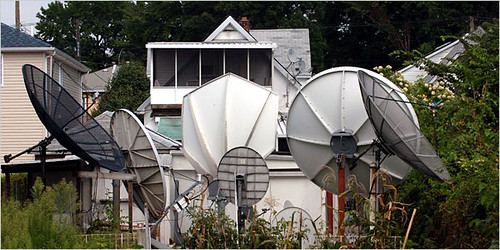Backyard International Teleport

Hats off to Doug Lung, who just published this masterfully researched piece in his weekly RF Report:
Last week the FBI raided Javed Iqbal’s Brooklyn storefront and his house in Staten Island, which was home to an FCC-licensed earth station (E040456). Iqbal was arrested for making available broadcasts from Al-Manar, a Hezbollah-controlled Arabic TV station based in Lebanon. Articles in the Washington Post and the New York Times cover the legal and political side of Javed Iqbal’s arrest but provide little information on Javed Iqbal’s HDTV Corp. satellite and uplink operation. I was intrigued by the operation of an uplink that has attracted worldwide attention from its owner’s back yard! Using information available on the FCC Web site, Lyngsat.com, Iqbal’s own Web site www.hdtvuplink.com and satellite operators’ Web sites, I was able to gain more insight into the technical operations of HDTV Corp.
According to its Web site, HDTV Corp.’s customers include several government agencies: FEMA, the FBI, the U.S. Department of State, NASA, the U.S. House of Representatives and others. Several large international companies, including Shell, Exxon Mobil, General Dynamics and Fluor are also listed as customers.
Once you’ve browsed through the HDTV Corp. Web site take a look at the picture at the top of the article, "New York Man Charged With Enabling Hezbollah Television Broadcasts". Information on Iqbal’s uplink is available using the Quick Search feature on the FCC International Bureau’s IBFS Web page. The only license I could find using his company name — HDTV.LTD is what shows up in the FCC database — and his FRN 0011344298 was E040456, granted in January 2005. This authorizes a Ku-band uplink at 242 Van Ness Avenuein Staten Island, NY. The application for the license specifies "ALSAT" as the points of communication (these are all the U.S. licensed satellites, plus those on the FCC’s permitted list) and shows the antenna as a Radiation Systems 240AT 2.4-meter dish. Maximum input power is listed as 290 watts. Can you find that satellite dish in the photo?
News reports indicated that Iqbal was arrested because he was supporting terrorist activities. At least one report notes that since the U.S. has determined Hezbollah is a terrorist organization, doing business with it is a clear violation of U.S. law. How did Iqbal bring Hezbollah programming into the U.S.? It is unlikely he paid Hezbollah for the programming. According to the premier source of satellite information, LyngSat.com, Al-Manar TV, the Hezbollah channel Iqbal was arrested for distributing, is available on at least three satellites, Arabsat 2B, Badr 3, and Nilesat 102 at no charge. My research showed none of these satellites have a footprint that reaches the U.S. However, www.hdtvuplink.com says HDTV Corp. has teleports in the Pakistan and the United Kingdom, where the Al-Manar satellites can be received.
The LyngSat listing for the Amazonas satellite at 61 degrees WL shows HDTV Corp. as having a portion of transponder 1(V), at 11,972 MHz. The LyngSat listing for HDTV Teleport shows Iqbal’s company had access to Telstar 12, Hispasat 1C, as well as Amazonas. Any of these could be used to relay signals from Pakistan or the United Kingdom to the United States.
Did Javed Iqbal simply provide a way for his customers in the United States to see Middle Eastern satellite broadcasts, or was he supporting or promoting terrorism through his relays? The Times article considers this. If the customer list is accurate, it appears that the U.S. government used his satellite services. It will be interesting to see how this case develops.
An article in today’s New York Sun, titled "D.C. Lobbyist is Key in Stopping Hezbollah Broadcasts," indicates that a Coalition Against Terrorist Media lobbyist may have been responsible for shutting down a satellite service that the U.S. State Department may have been using.
Could broadcasters be arrested for showing video from a terrorist organization? To follow this story, use this Google News search. While none of the articles have the technical detail I’ve provided here, they provide an interesting look at the legal issues in this case from several different perspectives, including possible First Amendment problems with the case.